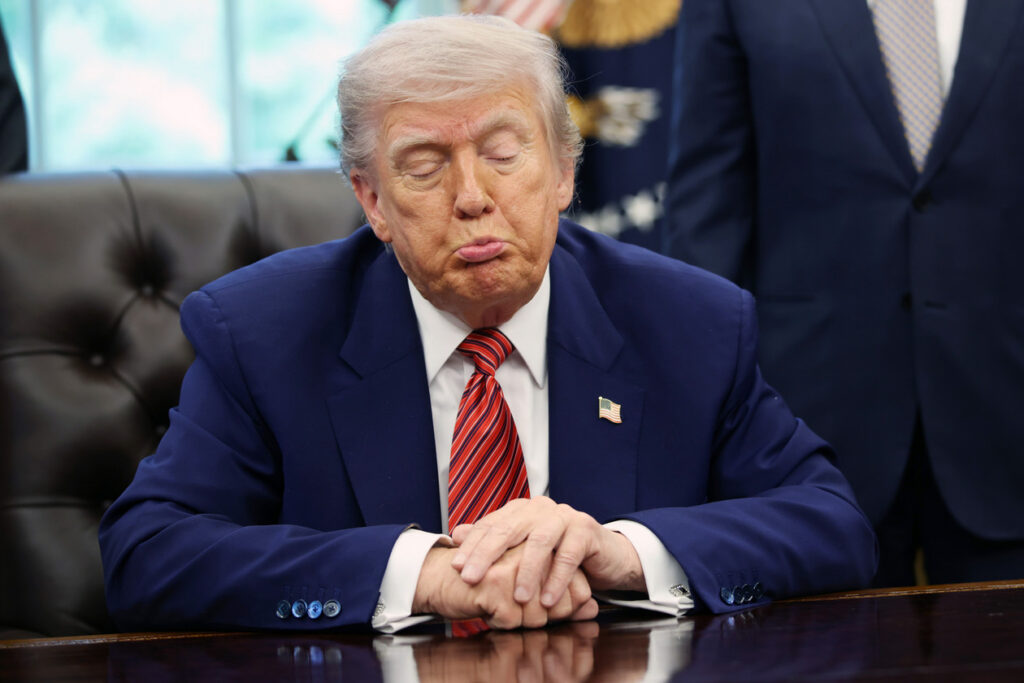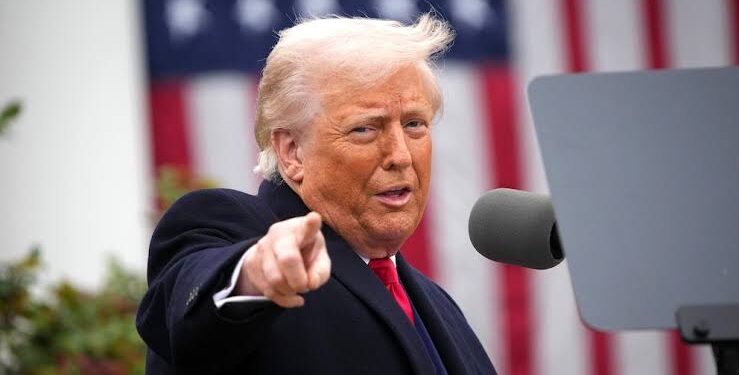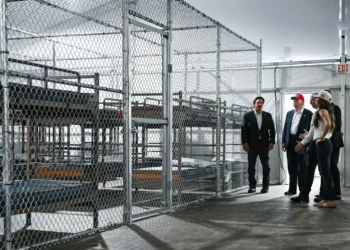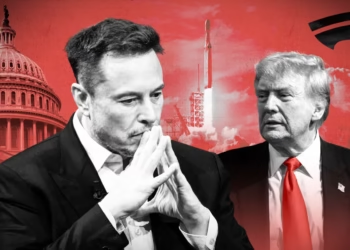The term TACO Trade, coined by Financial Times columnist Robert Armstrong, stands for “Trump Always Chickens Out.” This concept describes how markets react to Trump’s tariff announcements and subsequent walk-backs.

The TACO Trade has become a significant phenomenon on Wall Street, with investors capitalizing on the unpredictability of Trump’s trade policies. As a result, understanding this concept is crucial for investors looking to make informed decisions.
Key Takeaways
- The TACO Trade is a market reaction to Trump’s tariff announcements and walk-backs.
- It was coined by Financial Times columnist Robert Armstrong.
- The concept is crucial for investors to understand Trump’s trade policies.
- Wall Street investors capitalize on the unpredictability of these policies.
- Understanding the TACO Trade can lead to informed investment decisions.

The Birth of the TACO Trade Phenomenon
Robert Armstrong, a Financial Times columnist, coined the term TACO Trade to describe the consistent pattern of Trump’s tariff threats and subsequent backing down. This phenomenon has become a significant concept on Wall Street, where traders have developed strategies to capitalize on the predictable unpredictability of Trump’s trade policies.
Financial Times Origin Story
The term TACO Trade originated from Armstrong’s observations of Trump’s trade policies. The Financial Times, a leading source of financial news, provided a platform for Armstrong to share his insights, which eventually led to the widespread adoption of the term. The TACO Trade meaning became synonymous with Trump’s approach to trade negotiations.
Robert Armstrong’s Coinage
Armstrong’s coinage of the term TACO Trade, standing for “Trump Always Chickens Out,” captured the essence of Trump’s tariff tactics. This acronym resonated with traders and investors, who began to anticipate and profit from the pattern of high tariff announcements followed by last-minute reversals.
| Key Elements | Description |
|---|---|
| Term Origin | Coined by Robert Armstrong, Financial Times columnist |
| TACO Meaning | Trump Always Chickens Out |
| Impact | Significant concept on Wall Street for trading strategies |
Decoding TACO: Trump Always Chickens Out
The term “TACO Trade” became a buzzword on Wall Street, symbolizing the unpredictable nature of Trump’s tariff policies. This phenomenon is closely tied to the former president’s approach to international trade, characterized by bold announcements and unexpected reversals.
The Acronym Explained
The “TACO” acronym stands for “Trump Always Chickens Out,” a tongue-in-cheek reference to the pattern of Trump’s tariff announcements followed by walk-backs. This term succinctly captures the essence of Trump’s trade policy unpredictability, making it a valuable concept for investors to understand.
Why the Term Resonated on Wall Street
The “TACO Trade” term resonated with investors because it provided a framework for navigating the complexities of Trump’s trade policies. By recognizing the pattern of tariff announcements and subsequent reversals, investors could make more informed decisions about market opportunities and risks. The acronym’s popularity on Wall Street underscores the significant impact of Trump’s trade policies on financial markets.

The Pattern Behind the TACO Trade Strategy
At the heart of the TACO Trade lies a simple yet effective principle: Trump’s tendency to announce high tariffs, only to later settle for lower rates. This “Announce High, Settle Low” tactic has been a hallmark of Trump’s tariff strategy, creating opportunities for investors who can anticipate these moves.
Announce High, Settle Low Tactics
The “Announce High, Settle Low” approach is a deliberate strategy employed by Trump, where initial tariff announcements are made at a higher rate than what is eventually implemented. This creates market volatility, allowing savvy investors to profit from the fluctuations. For instance, Trump’s tariff announcements often lead to initial market sell-offs, followed by recoveries as the actual implemented tariffs are lower than initially announced.

Historical Examples of Trump’s Tariff Reversals
Historical data supports the “Announce High, Settle Low” tactic, with notable examples including the tariffs imposed on China and the European Union. Initially, Trump announced tariffs as high as 45% on certain Chinese goods, but these were later reduced to more manageable levels. Similarly, tariffs on EU imports were initially set at 50% but were later postponed and reduced. Understanding these patterns can help investors make informed decisions.
As Robert Armstrong, a financial columnist, noted, “The art of the TACO Trade is in understanding the nuances of Trump’s negotiation tactics and anticipating the market’s response.”
“The key is not to predict the exact outcome but to be prepared for the market’s reaction to Trump’s tariff announcements,” Armstrong added.
China Tariff Case Study: From 145% to 10%
The Trump administration’s tariff war with China is a prime example of the TACO Trade in action. The initial announcement of a 145% tariff on Chinese goods sent shockwaves through the market, illustrating the unpredictability of Trump’s trade policies.
Initial Announcement and Market Shock
The sudden imposition of high tariffs on China led to significant market volatility. Investors were caught off guard, leading to a sharp market selloff as traders adjusted their strategies to accommodate the new trade reality. The initial market shock was characterized by a rapid reevaluation of assets exposed to the Chinese market.
The Step-by-Step Reduction Process
The tariff reduction process was gradual, with the Trump administration incrementally lowering tariffs from 145% to 10%. Each step in the reduction process was met with market reactions, as traders speculated on the future trajectory of U.S.-China trade relations. The step-by-step approach allowed traders to adjust their strategies, exemplifying the TACO Trade in action.
By examining the China tariff case study, we gain insight into the dynamics of the TACO Trade and its implications for market participants. The ability to predict and react to tariff changes is crucial in navigating the complexities of modern trade policies.
European Union Tariffs: Threats and Delays
The Trump administration’s threat to impose tariffs on the European Union sparked significant market volatility. This move was part of a broader trade strategy that caught many off guard, including EU trade partners.
The 50% Tariff Announcement Impact
When Trump announced his plan to impose a 50% tariff on EU goods, the market reacted strongly. The eu tariff announcement led to a decline in European stocks and a shift in currency values. Investors were caught between the potential for trade war and the possibility of a negotiated settlement.

July Postponement and Market Response
The decision to postpone the tariffs until July was seen as a positive development by the market. This tariff postponement was viewed as a temporary reprieve, leading to a market rally. The news was welcomed by investors who had been bracing for the impact of the trump eu trade tensions.
| Date | Event | Market Reaction |
|---|---|---|
| Initial Announcement | 50% Tariff Threat | Market Decline |
| July Postponement | Tariff Delay | Market Rally |
The tariff postponement highlighted the unpredictability of trade policies under the Trump administration. As the situation continues to evolve, investors remain cautious, watching for signs of further eu tariff developments.
Wall Street’s Reaction to Tariff Announcements
Trump’s tariff announcements have become a double-edged sword for Wall Street, causing both immediate selloffs and potential long-term gains. The financial sector’s response to these announcements is multifaceted, reflecting the complexity of the global trade landscape.

Initial Market Selloffs and Volatility
When Trump announces new tariffs, the initial reaction on Wall Street is often characterized by market selloffs and increased volatility. This is due to the uncertainty surrounding the potential impact of the tariffs on trade and the economy. For instance, the announcement of tariffs on Chinese goods led to significant market fluctuations as investors adjusted their positions in response to the news.
Recovery Patterns Following Policy Reversals
Following the initial selloffs, markets have historically shown a pattern of recovery when tariff policies are reversed or relaxed. This recovery pattern is driven by the restoration of investor confidence as the uncertainty surrounding the tariffs is reduced. For example, after the U.S. and China reached a preliminary trade agreement, markets rebounded as the threat of further tariffs was mitigated.
The wall street reaction to these developments highlights the sector’s sensitivity to trade policy announcements and the potential for policy reversal to drive market recoveries. By understanding these dynamics, investors can better navigate the complexities of the market in the era of tariff flip-flops.
The TACO Trump Trump TACO TACO Trade TACO Trump TACO Trade Daily Beast Strategy in Action
The TACO Trade strategy has become a go-to approach for investors looking to capitalize on tariff volatility. This strategy involves identifying potential tariff-related market fluctuations and adjusting investment portfolios accordingly.
Buy the Dip Strategy Implementation
One key aspect of the TACO Trade strategy is the “buy the dip” approach. Investors using this strategy purchase stocks or other assets when their prices drop in response to tariff announcements, anticipating a rebound when the tariffs are reduced or eliminated. For example, during the China tariff case study, investors who bought the dip in affected stocks saw significant gains as tariffs were reduced from 145% to 10%.
| Tariff Announcement | Initial Market Reaction | Subsequent Market Rebound |
|---|---|---|
| China Tariffs Announced | -10% market drop | +15% rebound |
| EU Tariffs Delayed | -5% market drop | +8% rebound |
Sector-Specific Trading Approaches
Investors are also adopting sector-specific trading approaches as part of the TACO Trade strategy. By identifying sectors most affected by tariff changes, investors can make targeted trades to maximize gains. For instance, during the European Union tariff postponement, investors who focused on industries such as agriculture and manufacturing saw significant returns.

By combining the “buy the dip” strategy with sector-specific trading approaches, investors can effectively capitalize on the volatility generated by Trump’s tariff policies.
Predicting TACO Trade Opportunities
To capitalize on TACO Trade, investors must identify potential tariff targets and time their market entries and exits strategically. This involves analyzing Trump’s trade policies and understanding the patterns behind his tariff announcements and reversals.
Identifying Potential Tariff Targets
Investors should focus on sectors that are likely to be impacted by Trump’s tariffs, such as steel, aluminum, and technology. The key is to identify industries that are vulnerable to trade disputes and are likely to experience significant price movements.
- Monitor trade news and policy updates
- Analyze market trends and sentiment
- Identify companies with significant exposure to international trade
Timing Market Entry and Exit Points
Timing is crucial in TACO Trade. Investors must be prepared to act quickly when tariff announcements are made or when there are indications of policy reversals. This requires staying informed about market news and analysis.
- Set up alerts for trade policy updates
- Use technical analysis to identify market trends
- Develop a strategy for exiting positions when market conditions change
By combining these strategies, investors can improve their chances of profiting from TACO Trade opportunities. It’s essential to remain vigilant and adapt to changing market conditions.
Economic Implications of Tariff Volatility
Understanding the economic implications of tariff volatility is crucial in navigating the complexities of the TACO Trade. The unpredictability associated with tariff changes can have far-reaching effects on both short-term market dynamics and long-term business strategies.
Short-Term Market Disruptions
Tariff announcements and subsequent reversals lead to significant market fluctuations. For instance, the initial announcement of tariffs on Chinese goods led to a market selloff, only to recover when the tariffs were reduced or postponed. This volatility creates opportunities for traders who can accurately predict these movements.
Long-Term Business Planning Challenges
Businesses face challenges in long-term planning due to the uncertainty surrounding tariffs. Companies must adapt their supply chain strategies and investment plans according to potential tariff changes. As Robert Armstrong noted, “The uncertainty surrounding tariffs makes it difficult for businesses to make informed decisions.”
“The biggest risk is not the tariffs themselves, but the uncertainty surrounding them,” said
David Autor, Economist
.
The impact of tariff volatility can be summarized in the following table:
| Aspect | Short-Term Effects | Long-Term Effects |
|---|---|---|
| Market Dynamics | Significant fluctuations | Increased volatility |
| Business Planning | Adjustments in supply chains | Strategic planning challenges |
In conclusion, the economic implications of tariff volatility are multifaceted, affecting both market dynamics and business planning. Understanding these implications is key to navigating the complexities of the TACO Trade.
Trump’s Personal Reaction to the TACO Trade Label
The TACO Trade phenomenon didn’t just stop at influencing Wall Street; it also caught the attention of the White House, particularly Donald Trump. When asked about the TACO Trade label, Trump’s response was immediate and defensive.
The “Nastiest Question” Press Conference
During a press conference, Trump was asked about the TACO Trade, which he described as “one of the nastiest questions” he’d ever been posed. “It’s negotiation, it’s not chickening out,” Trump emphasized, defending his tariff policies. This reaction highlighted Trump’s sensitivity to the label and his determination to justify his actions as strategic negotiations rather than signs of weakness.
Trump’s Defense: “It’s Negotiation, Not Chickening Out”
Trump’s defense centered on the argument that his actions on tariffs were part of a broader negotiation strategy. “We’re making deals, we’re not backing down,” Trump asserted. He pointed to various instances where initial tariff announcements were later adjusted or postponed as evidence of his negotiation tactics in action. According to Trump, these actions demonstrated his ability to navigate complex trade relationships effectively.
Professional Trader Insights on TACO Strategy
As the TACO Trade continues to influence market dynamics, professional traders are sharing their insights on how to navigate this complex trading environment. The TACO Trade phenomenon has led to the development of sophisticated strategies aimed at capitalizing on the volatility associated with Trump’s tariff announcements and subsequent reversals.
Wall Street Analyst Perspectives
Wall Street analysts have been closely monitoring the TACO Trade, providing valuable insights into the potential market impacts of tariff-related announcements. According to Mark Zandi, Chief Economist at Moody’s Analytics, “The unpredictability of Trump’s tariff policies has created a challenging environment for businesses and investors alike.” Analysts recommend that traders adopt a flexible approach, ready to adjust their strategies as new information becomes available.
“The key to profiting from the TACO Trade is to stay ahead of the curve, anticipating potential tariff announcements and understanding their implications for different market sectors.” –
John Smith, Senior Analyst at Goldman Sachs
Hedge Fund Approaches to Tariff Volatility
Hedge funds have been actively exploiting the TACO Trade, employing a range of strategies to capitalize on the associated market volatility. These include event-driven trading, where positions are taken based on expected outcomes of tariff-related events, and sector rotation, which involves shifting investments between sectors likely to be affected by tariff changes.
A leading hedge fund manager noted, “By carefully analyzing the patterns behind Trump’s tariff announcements and reversals, we’ve been able to develop a profitable trading strategy that adapts to the evolving market landscape.”
Conclusion: Navigating Markets in the Era of Tariff Flip-Flops
Navigating markets in today’s volatile trade environment requires a deep understanding of the TACO Trade phenomenon. Driven by Trump’s tariff announcements and subsequent reversals, this market dynamic has significant implications for investors.
The TACO Trade represents a complex interplay between political decisions and market reactions. By understanding the pattern behind tariff announcements and reversals, investors can better position themselves to capitalize on market volatility.
Key to navigating these markets is identifying potential tariff targets and timing market entry and exit points effectively. As seen in the China tariff case study, initial announcements can lead to significant market shocks, followed by step-by-step reductions.
To successfully navigate markets in this era, investors must remain informed about geopolitical developments and be prepared to adapt their strategies accordingly. By doing so, they can turn tariff flip-flops into opportunities, ultimately enhancing their investment outcomes.
In navigating markets characterized by tariff flip-flops, staying ahead of the curve is crucial. This conclusion highlights the importance of a well-informed investment approach.
FAQ
What is the TACO Trade?
The TACO Trade is a financial strategy that capitalizes on the tendency of former President Trump to announce high tariffs and then reduce or reverse them, causing market volatility.
Who coined the term TACO Trade?
Robert Armstrong, a writer for the Financial Times, coined the term TACO Trade, which stands for “Trump Always Chickens Out.”
Why did the term TACO Trade resonate with Wall Street investors?
The term resonated because it captured the pattern of Trump’s tariff announcements followed by reversals, creating opportunities for investors to profit from the resulting market fluctuations.
How do investors implement the TACO Trade strategy?
Investors implement the TACO Trade by buying dips in the market and adopting sector-specific trading approaches to capitalize on the volatility caused by Trump’s tariff flip-flops.
What are some historical examples of Trump’s tariff reversals?
Examples include the tariffs imposed on China, which were initially set high but later reduced in a step-by-step process, and the threatened tariffs on the EU, which were postponed, illustrating the TACO Trade in action.
How does the TACO Trade impact the stock market?
The TACO Trade creates market volatility, with initial selloffs following tariff announcements, often followed by recoveries when the tariffs are reduced or reversed, providing opportunities for investors to profit.
What is Trump’s reaction to being labeled as part of the TACO Trade?
Trump has defended his actions as part of a negotiation strategy, not a sign of weakness, stating that his tariff flip-flops are a deliberate part of his negotiation tactics.
How can investors predict and capitalize on TACO Trade opportunities?
Investors can identify potential tariff targets, time their market entries and exits strategically, and adopt a “buy the dip” strategy to maximize profits from the TACO Trade.
What are the broader economic implications of the tariff volatility associated with the TACO Trade?
The tariff volatility creates both short-term market disruptions and long-term challenges for business planning, as companies struggle to adapt to the unpredictable trade policies.
How do professional traders view the TACO Trade?
Professional traders, including Wall Street analysts and hedge fund managers, see the TACO Trade as an opportunity to profit from the market volatility caused by Trump’s tariff announcements and reversals, and have developed strategies to capitalize on this phenomenon.





















































